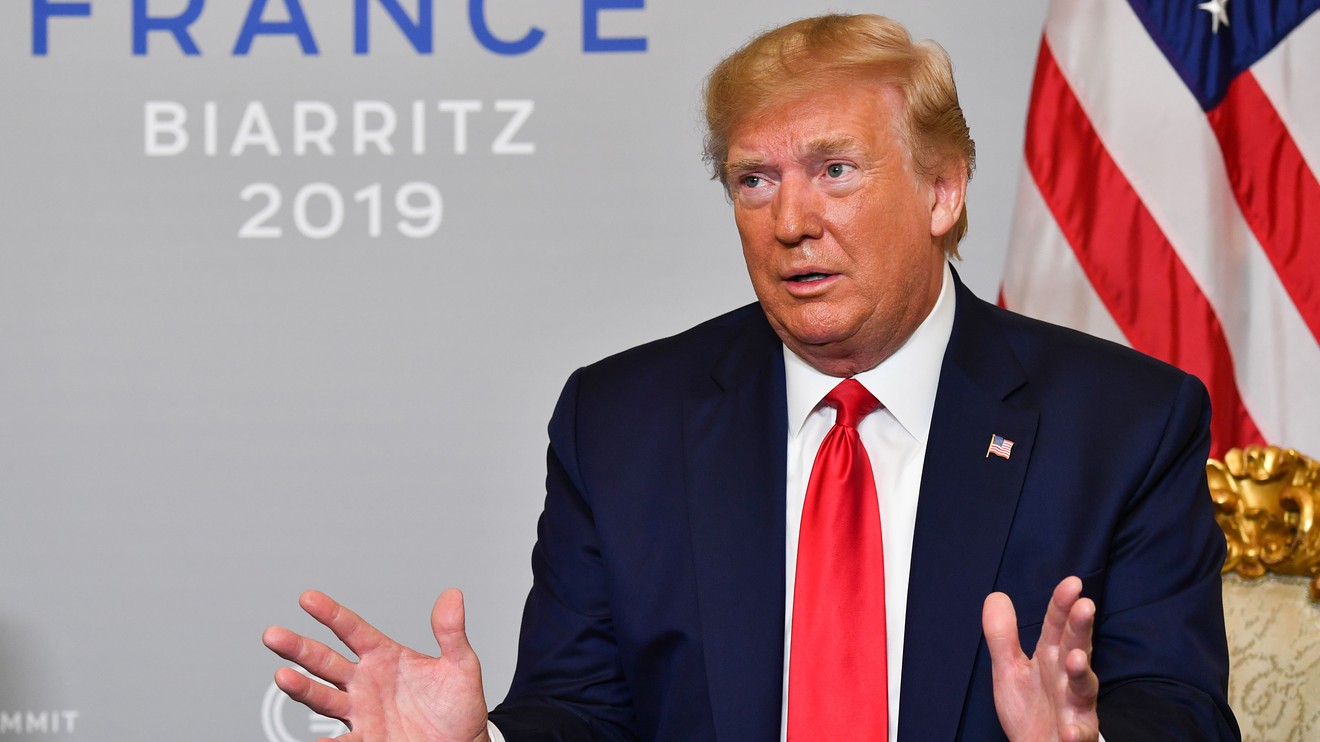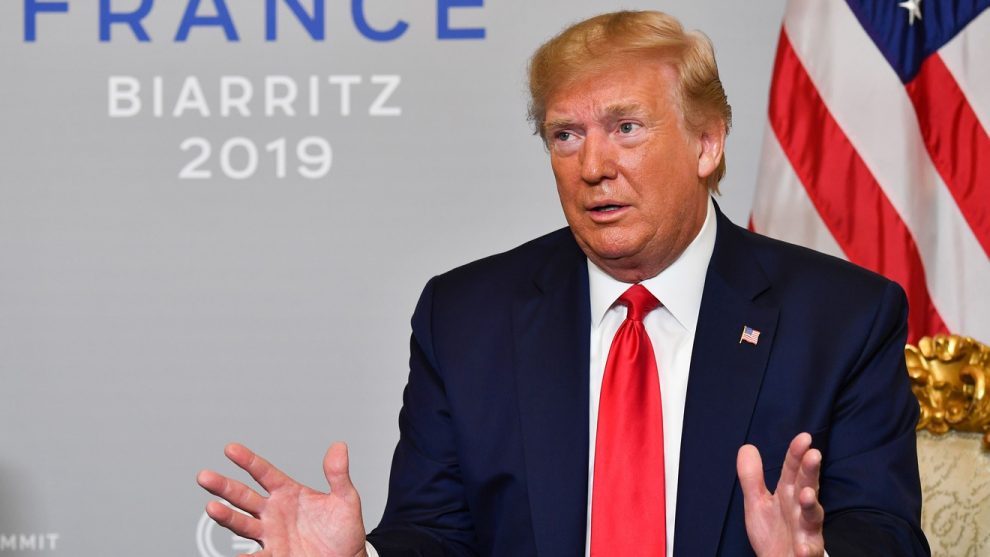
U.S. stocks posted healthy gains during official trade Monday after President Donald Trump said China wants to return to the negotiating table, in the wake of another round of tariffs announced Friday by Beijing and Washington.
How did the major benchmarks perform?
The Dow Jones Industrial Average DJIA, +1.05% rose 269.93 points, or 1.1%, to 25,898.83, while the S&P 500 index SPX, +1.10% gained 31.27 points, or 1.1%, to 2,878.38. The Nasdaq Composite Index COMP, +1.32% rose 101.97 points, or 1.3%, to 7,853.74.
Trading volumes were about 20% lower than average though, with the U.K. closed for a bank holiday. Despite the volatility induced by Trump’s tweets, the benchmark S&P 500 index remains in its 2,820 – 2,950 range so far in August.
On Friday the Dow tumbled 623.34 points, or 2.4%, to end at 25,628.90, leaving the blue-chip gauge with a 1% weekly decline. The S&P 500 fell 75.84 points, or 2.6%, to close at 2,847.11, a weekly fall of 1.4%. The Nasdaq Composite COMP, +1.32% dropped 239.62 points, or 3%, to end at 7,751.77, leaving it with a weekly fall of 1.8%.
What drove the market?
U.S. stocks shook off premarket weakness Monday to end the day in positive territory after Trump said negotiations would begin again in the wake of the U.S. receiving two “very good calls” from Beijing, even though the Chinese played down the significance of the calls. China’s vice premier and top trade negotiator, Liu He, did call for calm and urge dialogue in a speech, however.
During a press conference after the conclusion of the Group of 7 meeting in France, President Trump said he believes that China wants to make a trade deal “very badly.” Asked if he would considering delaying or canceling tariffs on China, the president said “anything’s possible.”
Trump’s comments follow a session of steep losses for U.S. stocks Friday, after Trump responded angrily on Twitter to China’s decision to levy retaliatory tariffs, saying that he “hereby ordered” U.S. companies to look for alternatives to China and to try to bring home manufacturing activity. Trump also announced after the market’s close Friday that the U.S. would raise tariffs on $250 billion worth of Chinese goods to 30% from 25%, while tariffs on $300 billion in imports from China would go to 15% from 10%.
U.S. companies are concerned about President Donald Trump’s threats to ban them from doing business in China, and they’re poised to halt new investments if the trade war escalates, said Josh Bolten, president and chief executive officer of the Business Roundtable and a former chief of staff to President George W. Bush in an interview on CNN.
“He has a lot of authority through the national security statutes to disrupt trade and commerce in a way that would cause huge damage — not just to the Chinese economy, but to the global economy and the U.S. economy,” Bolten said.
On the data front, orders for long-lasting manufactured goods rose 2.1% in July, the Commerce Department estimated Monday, above the 0.9% increase expected by economists polled by MarketWatch. Excluding transportation items, new orders declined by 0.4% though. Orders for core capital goods excluding defense and aircraft, a closely watched proxy for business investment, rose 0.4% in July, after a downwardly revised 0.9% rise in May, continuing a trend of slowing capex growth.
“The details for orders were not as strong as the headline data, which were boosted by a reversal of some of the recent weakness in the volatile and long-lead-time civilian aircraft component,” wrote Jim O’Sullivan chief U.S. economist at High Frequency Economics, in a Monday note to clients. “Through the volatility, trends [in capital spending] have slowed significantly.”
The Chicago Fed National Activity Index slowed to -0.36 in July from 0.03 in June, indicating the U.S. economy is growing below trend. The three-month moving average slowed to -0.19 in July from -0.15 in June.
In European economic data, the German Ifo Institute warned there are even more indications of a recession in Germany after its latest survey data. Headline business sentiment came in at its weakest level since November 2012 at 94.3 versus consensus 95.1 and prior 95.7. Ifo Institute said last time industrial companies demonstrated such pessimism was in the crisis year of 2009.
Which stocks were in focus?
Shares of Amgen Inc. AMGN, +3.18% rose 3.2% Monday, after the biotechnology firm announced an agreement to buy Otezla, a subsidiary of Celgene Corp. CELG, +3.20% for $13.4 billion in cash. Bristol-Myers Squibb Co. BMY, +3.28% said that the deal was part of the regulatory approval process for its pending acquisition of Celgene.
Pitney Bowes Inc. PBI, -8.31% said Monday that it was selling its software solutions business to data company Syncsort for $700 million. Shares fell 8.3%.
Shares of Dish Network Corp. DISH, +3.93% rose 3.9%, after Raymond James analyst Ric Prentiss issued a double-upgrade on the company the stock’s, which has fallen 9.3% during the past three months.
How did other markets trade?
The yield of the 10-year U.S. Treasury note TMUBMUSD10Y, -0.78% rose 1.4 basis point to 1.538%, while that of the 2-year note TMUBMUSD02Y, -0.56% added 0.4 basis point to end also at 1.535%.
Stocks in Asia closed sharply lower overnight, with the China CSI 300 000300, +1.68% falling 1.4%, Japan’s Nikkei 225 NIK, +1.04% tumbling 2.2% and the Hang Seng Index HSI, -0.07% retreating 1.9%. Stocks in Europe closed flat, according to the Stoxx Europe 600 SXXP, -0.02%.
In commodities markets, the price of crude oil CLV19, +0.47% fell 0.8% to $53.73 per barrel, while gold GCZ19, +0.07% rose less than 0.1% to $1538.30 per ounce. The U.S. dollar DXY, -0.10%, meanwhile, rose 0.4% relative to a basket of its major trading partners.









